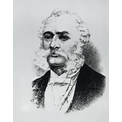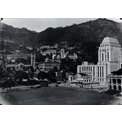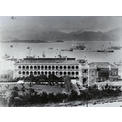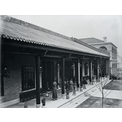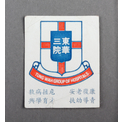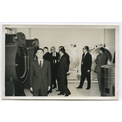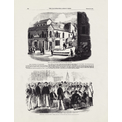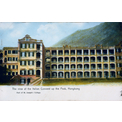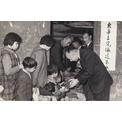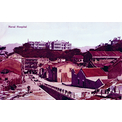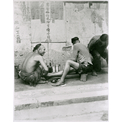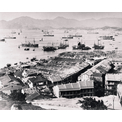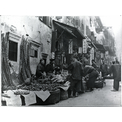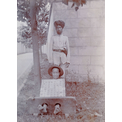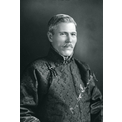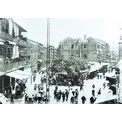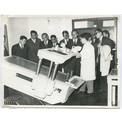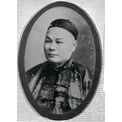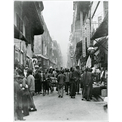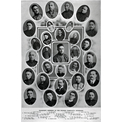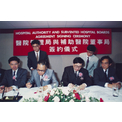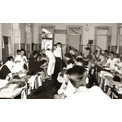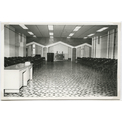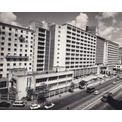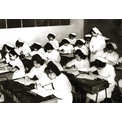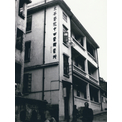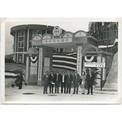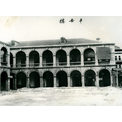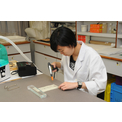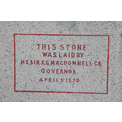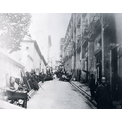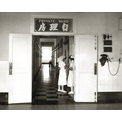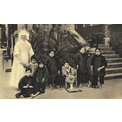 Collections
Collections Hong Kong, Benevolent City: Tung Wah and the Growth of Chinese Communities
Hong Kong, Benevolent City: Tung Wah and the Growth of Chinese Communities All Items
All Items Images
Images
Criminal wearing pillory being put on public display under watchful eye of Indian police officer
Although Hong Kong was already a colony, the British continued to impose traditional Chinese penal measures on criminals. This photograph shows a criminal wearing a pillory being put on public display under the watchful eye of an Indian police officer. Information such as the criminal's name, the crime he has committed and the site of the crime is written on the wooden sign he is wearing, so as to deter others from breaking the law. This photograph was taken in the 1910s.
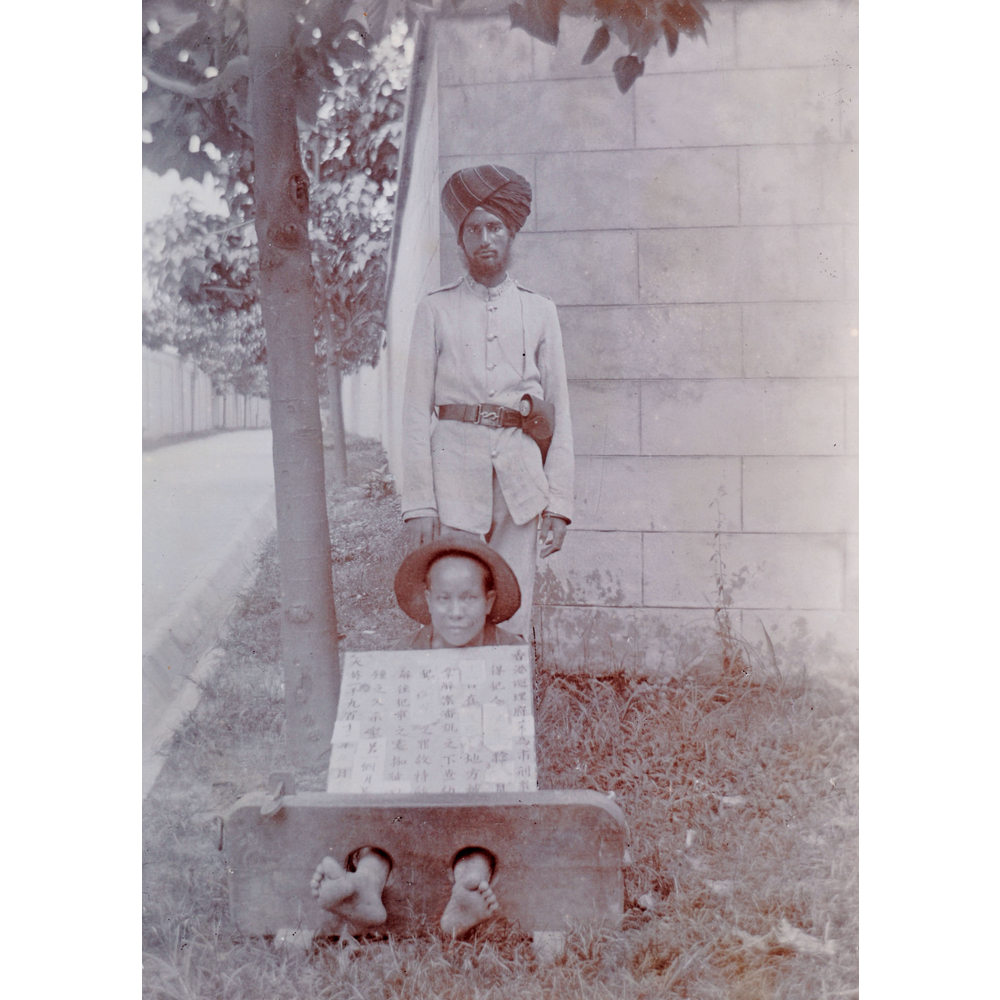
| Date | 1910s |
| people | Police |
| Material Type | Image |
| Collection | Hong Kong, Benevolent City: Tung Wah and the Growth of Chinese Communities |
| Source | Hong Kong Museum of History. Image Reference No.: P2008.268.49 |
| Repository | Hong Kong Museum of History |
| Note to Copyright | Permission for use in Hong Kong Memory is given by Hong Kong Museum of History |
| Accession No. | lcs-twgh-0005 |
Criminal wearing pillory being put on public display under watchful eye of Indian police officer
Although Hong Kong was already a colony, the British continued to impose traditional Chinese penal measures on criminals. This photograph shows a criminal wearing a pillory being put on public display under the watchful eye of an Indian police officer. Information such as the criminal's name, the crime he has committed and the site of the crime is written on the wooden sign he is wearing, so as to deter others from breaking the law. This photograph was taken in the 1910s.
| Date | 1910s |
| People | Police |
| Material Type | Image |
| Collection | Hong Kong, Benevolent City: Tung Wah and the Growth of Chinese Communities |
| Source | Hong Kong Museum of History. Image Reference No.: P2008.268.49 |
| Repository | Hong Kong Museum of History |
| Note to Copyright | Permission for use in Hong Kong Memory is given by Hong Kong Museum of History |
| Accession No. | lcs-twgh-0005 |
Criminal wearing pillory being put on public display under watchful eye of Indian police officer
Although Hong Kong was already a colony, the British continued to impose traditional Chinese penal measures on criminals. This photograph shows a criminal wearing a pillory being put on public display under the watchful eye of an Indian police officer. Information such as the criminal's name, the crime he has committed and the site of the crime is written on the wooden sign he is wearing, so as to deter others from breaking the law. This photograph was taken in the 1910s.
| Date | 1910s |
| People | Police |
| Material Type | Image |
| Collection | Hong Kong, Benevolent City: Tung Wah and the Growth of Chinese Communities |
| Source | Hong Kong Museum of History. Image Reference No.: P2008.268.49 |
| Repository | Hong Kong Museum of History |
| Note to Copyright | Permission for use in Hong Kong Memory is given by Hong Kong Museum of History |
| Accession No. | lcs-twgh-0005 |
Criminal wearing pillory being put on public display under watchful eye of Indian police officer
Although Hong Kong was already a colony, the British continued to impose traditional Chinese penal measures on criminals. This photograph shows a criminal wearing a pillory being put on public display under the watchful eye of an Indian police officer. Information such as the criminal's name, the crime he has committed and the site of the crime is written on the wooden sign he is wearing, so as to deter others from breaking the law. This photograph was taken in the 1910s.
| Date | 1910s |
| People | Police |
| Material Type | Image |
| Collection | Hong Kong, Benevolent City: Tung Wah and the Growth of Chinese Communities |
| Source | Hong Kong Museum of History. Image Reference No.: P2008.268.49 |
| Repository | Hong Kong Museum of History |
| Note to Copyright | Permission for use in Hong Kong Memory is given by Hong Kong Museum of History |
| Accession No. | lcs-twgh-0005 |
Criminal wearing pillory being put on public display under watchful eye of Indian police officer
Although Hong Kong was already a colony, the British continued to impose traditional Chinese penal measures on criminals. This photograph shows a criminal wearing a pillory being put on public display under the watchful eye of an Indian police officer. Information such as the criminal's name, the crime he has committed and the site of the crime is written on the wooden sign he is wearing, so as to deter others from breaking the law. This photograph was taken in the 1910s.
| Date | 1910s |
| People | Police |
| Material Type | Image |
| Collection | Hong Kong, Benevolent City: Tung Wah and the Growth of Chinese Communities |
| Source | Hong Kong Museum of History. Image Reference No.: P2008.268.49 |
| Repository | Hong Kong Museum of History |
| Note to Copyright | Permission for use in Hong Kong Memory is given by Hong Kong Museum of History |
| Accession No. | lcs-twgh-0005 |
Criminal wearing pillory being put on public display under watchful eye of Indian police officer
Although Hong Kong was already a colony, the British continued to impose traditional Chinese penal measures on criminals. This photograph shows a criminal wearing a pillory being put on public display under the watchful eye of an Indian police officer. Information such as the criminal's name, the crime he has committed and the site of the crime is written on the wooden sign he is wearing, so as to deter others from breaking the law. This photograph was taken in the 1910s.
| Date | 1910s |
| People | Police |
| Material Type | Image |
| Collection | Hong Kong, Benevolent City: Tung Wah and the Growth of Chinese Communities |
| Source | Hong Kong Museum of History. Image Reference No.: P2008.268.49 |
| Repository | Hong Kong Museum of History |
| Note to Copyright | Permission for use in Hong Kong Memory is given by Hong Kong Museum of History |
| Accession No. | lcs-twgh-0005 |
Criminal wearing pillory being put on public display under watchful eye of Indian police officer
Although Hong Kong was already a colony, the British continued to impose traditional Chinese penal measures on criminals. This photograph shows a criminal wearing a pillory being put on public display under the watchful eye of an Indian police officer. Information such as the criminal's name, the crime he has committed and the site of the crime is written on the wooden sign he is wearing, so as to deter others from breaking the law. This photograph was taken in the 1910s.
| Date | 1910s |
| People | Police |
| Material Type | Image |
| Collection | Hong Kong, Benevolent City: Tung Wah and the Growth of Chinese Communities |
| Source | Hong Kong Museum of History. Image Reference No.: P2008.268.49 |
| Repository | Hong Kong Museum of History |
| Note to Copyright | Permission for use in Hong Kong Memory is given by Hong Kong Museum of History |
| Accession No. | lcs-twgh-0005 |
Criminal wearing pillory being put on public display under watchful eye of Indian police officer
Although Hong Kong was already a colony, the British continued to impose traditional Chinese penal measures on criminals. This photograph shows a criminal wearing a pillory being put on public display under the watchful eye of an Indian police officer. Information such as the criminal's name, the crime he has committed and the site of the crime is written on the wooden sign he is wearing, so as to deter others from breaking the law. This photograph was taken in the 1910s.
| Date of Death | 1910s |
| People | Police |
| Material Type | Image |
| Collection | Hong Kong, Benevolent City: Tung Wah and the Growth of Chinese Communities |
| Source | Hong Kong Museum of History. Image Reference No.: P2008.268.49 |
| Repository | Hong Kong Museum of History |
| Note to Copyright | Permission for use in Hong Kong Memory is given by Hong Kong Museum of History |
| Accession No. | lcs-twgh-0005 |
Criminal wearing pillory being put on public display under watchful eye of Indian police officer
Although Hong Kong was already a colony, the British continued to impose traditional Chinese penal measures on criminals. This photograph shows a criminal wearing a pillory being put on public display under the watchful eye of an Indian police officer. Information such as the criminal's name, the crime he has committed and the site of the crime is written on the wooden sign he is wearing, so as to deter others from breaking the law. This photograph was taken in the 1910s.
| Date | 1910s |
| Material Type | Image |
| Collection | Hong Kong, Benevolent City: Tung Wah and the Growth of Chinese Communities |
| Source | Hong Kong Museum of History. Image Reference No.: P2008.268.49 |
| Note to Copyright | Permission for use in Hong Kong Memory is given by Hong Kong Museum of History |
| Accession No. | lcs-twgh-0005 |
Criminal wearing pillory being put on public display under watchful eye of Indian police officer
Although Hong Kong was already a colony, the British continued to impose traditional Chinese penal measures on criminals. This photograph shows a criminal wearing a pillory being put on public display under the watchful eye of an Indian police officer. Information such as the criminal's name, the crime he has committed and the site of the crime is written on the wooden sign he is wearing, so as to deter others from breaking the law. This photograph was taken in the 1910s.
| Date | 1910s |
| Material Type | Image |
| People | Police |
| Collection | Hong Kong, Benevolent City: Tung Wah and the Growth of Chinese Communities |
| Source | Hong Kong Museum of History. Image Reference No.: P2008.268.49 |
| Repository | Hong Kong Museum of History |
| Note to Copyright | Permission for use in Hong Kong Memory is given by Hong Kong Museum of History |
| Accession No. | lcs-twgh-0005 |
Criminal wearing pillory being put on public display under watchful eye of Indian police officer
Although Hong Kong was already a colony, the British continued to impose traditional Chinese penal measures on criminals. This photograph shows a criminal wearing a pillory being put on public display under the watchful eye of an Indian police officer. Information such as the criminal's name, the crime he has committed and the site of the crime is written on the wooden sign he is wearing, so as to deter others from breaking the law. This photograph was taken in the 1910s.
| Date | 1910s |
| People | Police |
| Material Type | Image |
| Collection | Hong Kong, Benevolent City: Tung Wah and the Growth of Chinese Communities |
| Source | Hong Kong Museum of History. Image Reference No.: P2008.268.49 |
| Repository | Hong Kong Museum of History |
| Note to Copyright | Permission for use in Hong Kong Memory is given by Hong Kong Museum of History |
| Accession No. | lcs-twgh-0005 |
Criminal wearing pillory being put on public display under watchful eye of Indian police officer
Although Hong Kong was already a colony, the British continued to impose traditional Chinese penal measures on criminals. This photograph shows a criminal wearing a pillory being put on public display under the watchful eye of an Indian police officer. Information such as the criminal's name, the crime he has committed and the site of the crime is written on the wooden sign he is wearing, so as to deter others from breaking the law. This photograph was taken in the 1910s.
| Date | 1910s |
| People | Police |
| Material Type | Image |
| Collection | Hong Kong, Benevolent City: Tung Wah and the Growth of Chinese Communities |
| Source | Hong Kong Museum of History. Image Reference No.: P2008.268.49 |
| Repository | Hong Kong Museum of History |
| Note to Copyright | Permission for use in Hong Kong Memory is given by Hong Kong Museum of History |
| Accession No. | lcs-twgh-0005 |
Criminal wearing pillory being put on public display under watchful eye of Indian police officer
Although Hong Kong was already a colony, the British continued to impose traditional Chinese penal measures on criminals. This photograph shows a criminal wearing a pillory being put on public display under the watchful eye of an Indian police officer. Information such as the criminal's name, the crime he has committed and the site of the crime is written on the wooden sign he is wearing, so as to deter others from breaking the law. This photograph was taken in the 1910s.
| Date | 1910s |
| People | Police |
| Material Type | Image |
| Collection | Hong Kong, Benevolent City: Tung Wah and the Growth of Chinese Communities |
| Source | Hong Kong Museum of History. Image Reference No.: P2008.268.49 |
| Repository | Hong Kong Museum of History |
| Note to Copyright | Permission for use in Hong Kong Memory is given by Hong Kong Museum of History |
| Accession No. | lcs-twgh-0005 |
Criminal wearing pillory being put on public display under watchful eye of Indian police officer
Although Hong Kong was already a colony, the British continued to impose traditional Chinese penal measures on criminals. This photograph shows a criminal wearing a pillory being put on public display under the watchful eye of an Indian police officer. Information such as the criminal's name, the crime he has committed and the site of the crime is written on the wooden sign he is wearing, so as to deter others from breaking the law. This photograph was taken in the 1910s.
| Date | 1910s |
| People | Police |
| Material Type | Image |
| Collection | Hong Kong, Benevolent City: Tung Wah and the Growth of Chinese Communities |
| Source | Hong Kong Museum of History. Image Reference No.: P2008.268.49 |
| Repository | Hong Kong Museum of History |
| Note to Copyright | Permission for use in Hong Kong Memory is given by Hong Kong Museum of History |
| Accession No. | lcs-twgh-0005 |
Criminal wearing pillory being put on public display under watchful eye of Indian police officer
Although Hong Kong was already a colony, the British continued to impose traditional Chinese penal measures on criminals. This photograph shows a criminal wearing a pillory being put on public display under the watchful eye of an Indian police officer. Information such as the criminal's name, the crime he has committed and the site of the crime is written on the wooden sign he is wearing, so as to deter others from breaking the law. This photograph was taken in the 1910s.
| Date | 1910s |
| People | Police |
| Material Type | Image |
| Collection | Hong Kong, Benevolent City: Tung Wah and the Growth of Chinese Communities |
| Source | Hong Kong Museum of History. Image Reference No.: P2008.268.49 |
| Repository | Hong Kong Museum of History |
| Note to Copyright | Permission for use in Hong Kong Memory is given by Hong Kong Museum of History |
| Accession No. | lcs-twgh-0005 |
Criminal wearing pillory being put on public display under watchful eye of Indian police officer
Although Hong Kong was already a colony, the British continued to impose traditional Chinese penal measures on criminals. This photograph shows a criminal wearing a pillory being put on public display under the watchful eye of an Indian police officer. Information such as the criminal's name, the crime he has committed and the site of the crime is written on the wooden sign he is wearing, so as to deter others from breaking the law. This photograph was taken in the 1910s.
| Date | 1910s |
| People | Police |
| Material Type | Image |
| Collection | Hong Kong, Benevolent City: Tung Wah and the Growth of Chinese Communities |
| Source | Hong Kong Museum of History. Image Reference No.: P2008.268.49 |
| Repository | Hong Kong Museum of History |
| Note to Copyright | Permission for use in Hong Kong Memory is given by Hong Kong Museum of History |
| Accession No. | lcs-twgh-0005 |
Criminal wearing pillory being put on public display under watchful eye of Indian police officer
Although Hong Kong was already a colony, the British continued to impose traditional Chinese penal measures on criminals. This photograph shows a criminal wearing a pillory being put on public display under the watchful eye of an Indian police officer. Information such as the criminal's name, the crime he has committed and the site of the crime is written on the wooden sign he is wearing, so as to deter others from breaking the law. This photograph was taken in the 1910s.
| Date | 1910s |
| People | Police |
| Material Type | Image |
| Collection | Hong Kong, Benevolent City: Tung Wah and the Growth of Chinese Communities |
| Source | Hong Kong Museum of History. Image Reference No.: P2008.268.49 |
| Repository | Hong Kong Museum of History |
| Note to Copyright | Permission for use in Hong Kong Memory is given by Hong Kong Museum of History |
| Accession No. | lcs-twgh-0005 |
Criminal wearing pillory being put on public display under watchful eye of Indian police officer
Although Hong Kong was already a colony, the British continued to impose traditional Chinese penal measures on criminals. This photograph shows a criminal wearing a pillory being put on public display under the watchful eye of an Indian police officer. Information such as the criminal's name, the crime he has committed and the site of the crime is written on the wooden sign he is wearing, so as to deter others from breaking the law. This photograph was taken in the 1910s.
| Date | 1910s |
| People | Police |
| Material Type | Image |
| Collection | Hong Kong, Benevolent City: Tung Wah and the Growth of Chinese Communities |
| Source | Hong Kong Museum of History. Image Reference No.: P2008.268.49 |
| Repository | Hong Kong Museum of History |
| Note to Copyright | Permission for use in Hong Kong Memory is given by Hong Kong Museum of History |
| Accession No. | lcs-twgh-0005 |
Copyright © 2012 Hong Kong Memory
